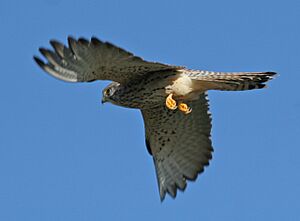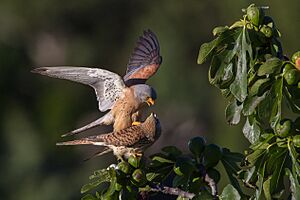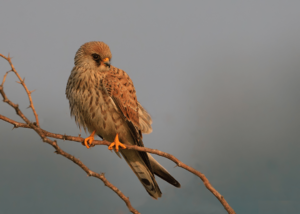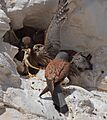Lesser kestrel facts for kids
The lesser kestrel (Falco naumanni) is a small falcon. These birds live in many places, from the Mediterranean Sea area across Afghanistan and Central Asia, all the way to China and Mongolia. They are migratory birds, meaning they fly south for the winter. They spend their winters in Africa and Pakistan, sometimes even going to India and Iraq. It's rare to see them far north of where they breed, and their numbers are going down in Europe. The name Falco comes from a Latin word for "sickle," which describes the bird's claws. The name naumanni honors a German scientist named Johann Friedrich Naumann.
Quick facts for kids Lesser kestrel |
|
|---|---|
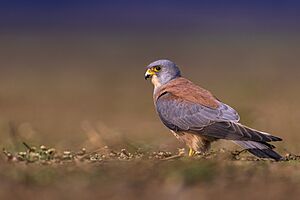 |
|
| Male | |
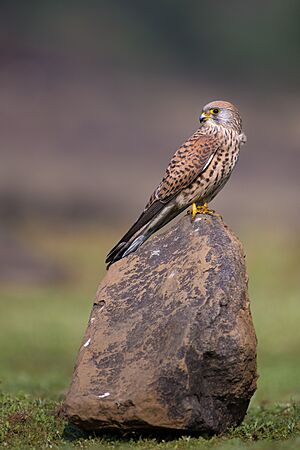 |
|
| Female | |
| Conservation status | |
| Scientific classification | |
| Genus: |
Falco
|
| Species: |
naumanni
|
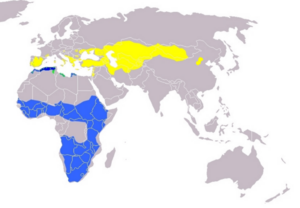 |
|
| Range of F. naumanni Breeding range Year-round range Wintering range | |
Contents
What Does a Lesser Kestrel Look Like?
The lesser kestrel is a small bird of prey. It is about 27–33 cm (11–13 in) long, which is about the length of a ruler. Its wingspan, how wide its wings are when spread out, is about 63–72 cm (25–28 in).
It looks a lot like the slightly bigger common kestrel. However, the lesser kestrel has shorter wings and tail for its size. Both species have brown backs and grey stripes on their undersides.
Male lesser kestrels have a grey head and tail, just like male common kestrels. But lesser kestrels do not have dark spots on their backs. They also lack the black stripe near their eye (called a malar stripe). Male lesser kestrels have grey patches on their wings.
Female and young lesser kestrels are a bit lighter in color than common kestrels. They look so similar that it's often easier to tell them apart by their calls or how they fly. The lesser kestrel makes a harsh chay-chay-chay sound. This is different from the common kestrel's kee-kee-kee.
One special thing about lesser kestrels is their talons (claws). Unlike most falcons, their talons are not dark. Instead, they are a light whitish-horn color. You can usually only see this unique color if you are very close to the bird.
How Lesser Kestrels Are Related to Other Birds
Even though the lesser kestrel looks very similar to the common kestrel, scientists believe they are not closely related. DNA studies show that the lesser kestrel is an older type of kestrel. It split off from other kestrels a long time ago, possibly between 7 and 3.5 million years ago.
The fact that it looks so much like the common kestrel is a bit of a mystery. However, some clues suggest its true family ties. For example, the lesser kestrel does not have a dark stripe near its eye. This feature is thought to be an older trait for kestrels. Also, its grey wing color is shared with most other Falco species, but not with the other "true" kestrels.
Life and Habits of the Lesser Kestrel
The lesser kestrel is smaller and more delicate than the common kestrel. They often live in the same areas. They compete a little bit for food and nesting spots. It's possible that looking similar to the larger common kestrel helps the lesser kestrel. If a predator thinks it's a bigger, tougher bird, it might leave the lesser kestrel alone. This is a type of natural defense.
Lesser kestrels mostly eat insects. They also hunt small birds, reptiles, and rodents, especially mice. They often catch their prey on the ground.
These birds nest in groups, called colonies. They build their nests on buildings, cliffs, or in holes in trees. A female lesser kestrel can lay between 3 and 6 eggs. Like other falcons, they do not build a fancy nest structure. They simply lay their eggs in a suitable spot.
When they fly south for the winter, lesser kestrels often go to West Africa. They especially like an area in Senegal where there are lots of locusts and grasshoppers. In 2007, scientists found a huge group of 28,600 lesser kestrels roosting together in Senegal. They were sharing the roost with 16,000 scissor-tailed kites!
The lesser kestrel is found in many places around the world. Its population is considered stable, so the IUCN (a group that tracks animal populations) lists it as "Least Concern." This means it is not currently at high risk of disappearing. However, using too many pesticides can harm these birds. This is because pesticides kill the insects that lesser kestrels rely on for food.
Gallery
-
Lesser kestrel with insect. Notice yellow talons - an easy way to distinguish between lesser and common kestrel
-
Male lesser kestrel feeding his chicks with Laudakia stellio, Negev desert, Israel



